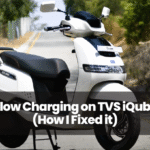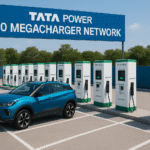In the 2024-25 Fiscal Year, the Indian electric vehicle (EV) sector broke records, with sales going beyond 2 million units, hence changing the EV scenario in the country.
This milestone is the reason behind India’s speeding transition to green mobility, with electric two-wheelers dominating the market and occupying more than half the market. This has also set the stage for India’s future mobility sustainability towards a better approach.
Segment-Wise EV Sales Breakdown
In India’s EV growth story in FY25, two-wheeler electric vehicles accounted for more than 50% of total sales, taking the lead. This segment grew by 19%; meanwhile, Ola Electric, TVS Motors, and Bajaj together captured over 70% market share.
In India, electric two-wheelers are cheap and convenient, making them the first choice for middle-class families in an affordable price range. In the electric car segment, sales increased by 11%, with Tata Motors holding a commanding 53% share in this area, followed by MG Motor at 28%.
Electric three-wheelers (E3Ws), both in passenger-car and delivery versions, had good growth as well, with an 11% YoY rate of increase. The leading companies were Mahindra, Bajaj Auto, and YC Electric. Whereas electric buses (E-Bus) suffered a 3% drop, Tata Motors, together with Olectra Greentech and PMI Electro, accounted for 69% of sales.
Top Performing States
In FY25, Uttar Pradesh once again emerged as the leader in Electric Vehicle adoption, followed by Maharashtra, Karnataka, Tamil Nadu, and Bihar.
These five states together accounted for some 50% of India’s overall buying volume for electric vehicles, which shows that whole regions are rapidly transitioning to electric transportation alternatives.
Particularly noteworthy is Bihar’s first-time appearance in the Top 5, replacing Delhi. This suggests a growing appetite for EVs beyond traditional urban centers.
The biggest advantage of Uttar Pradesh’s lead was the strong demand for electric three-wheelers, particularly because they were well-suited to semi-urban and rural areas.
Maharashtra and Karnataka continued because of their good EV policies and infrastructure. Tamil Nadu’s manufacturing system supplied a productive ground for EVs to grow.
Meanwhile, Bihar’s emergence highlights the changing nature of a country where even emerging markets become participants in India’s mission for clean mobility, which is something to note.
Government Support and Future Outlook
In speeding up the spread of electric vehicles, the Indian government continues to play a key role. The newly launched PM e-Bus Sewa and PM E-DRIVE scheme have a combined outlay of ₹10,900 crore until March 2026.
This seeks to support both EV manufacturing and infrastructure. By 2030, the Ministry of Heavy Industries believes that 60–70% of two-wheeled vehicles in India will be electric.
Such policies will make it possible for local manufacturing, subsidies, and all manner of local incentives to significantly reduce costs and further expand access. This will be helpful, particularly for tier-2 and tier-3 cities, becoming a nationwide electric mobility revolution.
With two million-plus sales recorded in FY25, India’s EV journey is gathering steam. A watershed moment in delivering environmentally friendly transportation has been made possible.
Two-wheelers are the game changers, which have been the leader with the support of robust government support and growing adoption across states.
By becoming a global center for clean and electric mobility, the nation’s future seems as bright as it can be.







